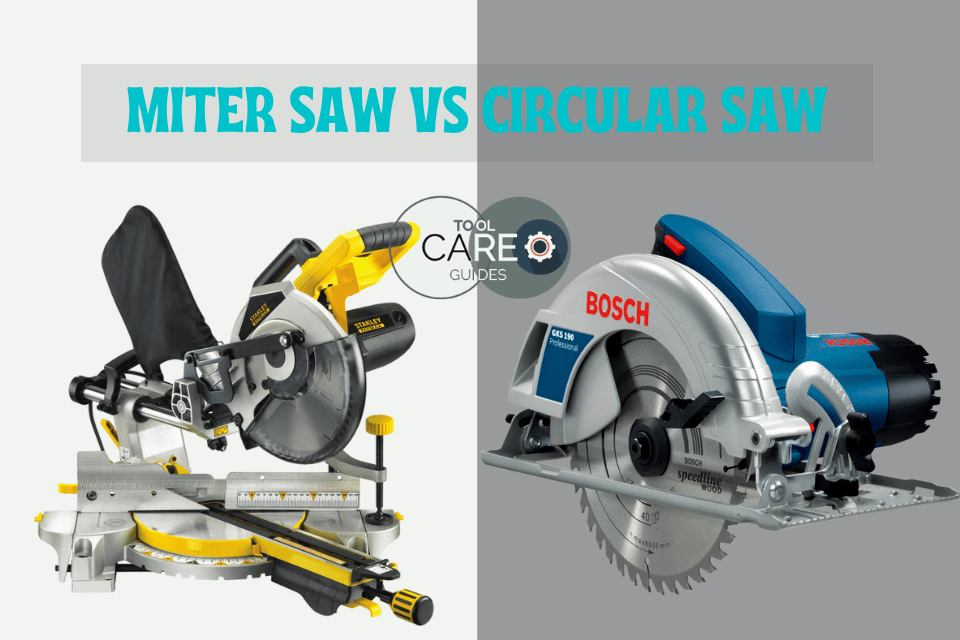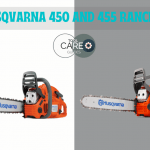Quick Overview of This Article
Do not confuse a miter saw for a circular saw! Both have a circular blade, but the main difference is the cutting angle.
Of course, there are other differences like price, types of cuts, storage, and portability. But let’s first examine these two power saws.
A miter and circular saw come top on the most powerful tools with wider application in the DIY world. With any of these two saws in your store, you can work on almost any type of material in your homestead, be it splitting a plank of wood, chopping firewood, metal, plastic, or trimming joints and additions.
Each tool has its specific functions, but you will find that the functions are similar; thus, the need to differentiate the two. In most cases, you will need the two saws in your workshop.
We compare further in this article miter saw vs circular saw for you to figure out the perfect choice for all your DIY or professional projects. But before we make the comparison, let’s get into finer details about each one of these saws.
WHAT IS A MITER SAW?
A miter saw is a perfected tool for cutting miters precisely, quickly, and conveniently. The tool comes in a circular blade that allows you to cut wood at specific angles. But you cannot move the saw around because you have to place it stationary on a table or stand.
When you walk into a saws’ store, you will find two categories of these saws; the cordless and the corded miter saws.
- Cordless Miter Saws
The cordless miter saw is battery powered, thus no cable, making it easy to move around. With a speed of up to 5700 RPM, the tool is a powerful beast that can reap any plank of wood around. Lumberjacks refer to the tool as a luxury power saw with LED lights, laser sightlines, and dust blowers. It is undoubtedly, one of the perfect accompaniments for professional contractors.
- Corded Miter Saws
This miter saw comes with an electrical outlet for power. The commonest sizes for the saw are 10″, 11″, and 12″. Corded miter saws are divided into five types; sliding, standard, compound, dual compound, and compound sliding saws.
Whether corded or cordless, miter saws cut their preys in four different ways;
Miter cut
This saw cuts an angle at the end of a wood or board. A miter saw would give you a forty-five-degree fitting where the two trims meet if you want to trim a window.
Crosscut
This is a common and easy cut where you put a plank or board through the length at 90 degrees standard angle. You can cut a four by six and split it into two by six without making any mistakes.
Compound cut
A compound cut is great for creating a crowning angle. An example is where you are looking to fit two trims perfectly in a corner. You will require a compound cut combined with a bevel cut.
Bevel cut
This type of cut passes through the wood’s thickness and is great for doorsteps and shims. A bevel cut focuses on thickness instead of width. An example is cutting a meeting point for two baseboards such that they create a beveled cover-up.
What Features Would I Find On A Miter Saw?
A miter saw has many features. Some of the features are relative to a circular saw, but others are different. Have a look at the list below to differentiate the saw from its closest relative; circular saw.
- Tungsten carbide circular blade ( 10inches to 12 inches)
- Blade teeth: 32 to 100
- Motor ( for the corded model)
- Battery (for cordless models)
- Miter scale
- Maximum speed: 5,000 RPM.
- Cuts: 45 degrees to 90 degrees
- Dedicated to crosscuts
- Sawdust collection mechanism
- No rip cuts
- Portable but requires a worktop to place
- Requires that you drop the target for a cut.
When to go for a miter saw
Reaching the final decision to consider a miter saw should not be a daunting task. When you go for the saw, you need to consider the kind of task ahead of you.
With the listed features above, you now understand that you will be using the saw because of its precision and accuracy in curating angles on your targets.
You can go for a miter saw to carry out trimming tasks such as carpentry and joinery. Most carpentry work involves bevel, compound, and crosscuts; thus, a more accurate power saw.
With a miter saw, expect to drop the blade on your target for cutting, but it will not be a challenge with enough practice and mastery of its ergonomics.
Our advice is that if you do specialty jobs regularly in a busy workshop, get a miter saw; otherwise, spending highly on the saw for a single task would not be logical. A different kind of saw will be more ideal in such a setup.
PROS & CONS of miter saw
Like any workshop tool, a miter saw has both the brighter and the dull side, and that’s how we will be able to compare it with its sister saw, the circular saw. So what is the brighter side of this power tool?
Pros
- Classy: A miter saw is a classy saw that comes with four settings for different cuts. When you fo for this saw, you are purchasing the extra features that count on convenience when cutting. But all this comes with a cost!
- Accurate and precise angles and bevel cuts for trims.
- No guide on usage
- No kickbacks
- Saves time
- Makes bevel, compound, miter, and crosscut.
Cons
- Quite expensive: A miter saw is a luxury and convenient tool. The reason is, its functions are a duplicate of the circular saw. What a miter saw can do, the circular saw can do but with less accuracy.
- Consumes space: A miter saw is large and also requires its table to stand.
- Less portability: the size of a miter saw makes moving around with the tool difficult.
- Less versatile: singly for making special cuts and angles.
- Does not make rip cuts.
WHAT IS A CIRCULAR SAW?
Professionals, homemakers, and DIYers find a circular saw an element of accomplishment in every cutting task ahead of them. Whether it is cutting wood, stones, metal, plastics, et cetera, the saw is on point.
Its teeth make 80-degree cuts and any other angle that befits your task. It is simple for you; all you need is to measure and outline the marks on the target, place it on the circular saw and make the cut you want with the miter saw. Everything else will follow accurately to give you a foolproof cut.
You will not miss a circular saw in most workshops, garages, and homeowners stores. The reason is the saw’s capabilities to chop, rip, and cut different styles through various materials impressively.
Unlike the miter saw, where you bring the target to the blade for cutting, the circular saw delivers the blade to wood, board, stone, or metal.
Also, the tool is small and portable, thus, allowing you more flexibility as you cut. That is why you will find many users preferring circular saws because of their multi-use in a variety of projects, including tiles, wood, metal, plastics, pipes, et cetera.
The only important thing to note is that you will be required to swap blades for the different materials, which is more convenient than having several saws for specific materials. When cutting different materials, get the appropriate blade so that your blade and teeth last longer.
Generally, the circular saw blades are super tough if you use them appropriately. The total teeth range from 18 to 20 depending on the size of the saw and are pure carbide and diamond or tungsten tipped.
Like miter saws, circular saws operate as corded or cordless for the electric and battery-operated motors. Both motors run at 15 Amps with 5,300 RPMs speed. No wonder professionals treasure and trust the tool in their multi-purpose setups.
What Features Would I Find On A Circular Saw?
- 5300 RPM
- Corded and/ cordless models
- 18 – 20 teeth
- carbide teeth
- Small and portable
- Versatile and powerful
- Averagely accurate
- Cuts plywood
- Makes bevel, compound, miter, cross, and rip cuts
When to go for a circular saw
When you go for this saw, you will be taking home an averagely accurate tool for your cutting needs. That is, if you compare it with its counterpart, the miter saw. A circular saw will cut large and small cuts and even outshine a variety of saws.
This saw is also quality. Its material is carbide with tungsten or diamond tips and arguably the most durable in the cutting tools industry. As mentioned, its performance is excellent and perfectly rip-cut straight edges from sheets of hardboards.
The saw has a clamp to hold your target, but the high-end models also come with ready-made guide rails. These help you to rip more accurate straight cuts.
If you are more particular about specs, you can go for the newest model in the market. It has a tilt base that helps you to make more accurate bevel cuts.
Overall, a circular saw is a multi-use saw for professionals and beginners in home maintenance, woodwork, metalwork, plastic works, and all sorts of work that require cutting.
PROS & CONS of circular saw
Generally, circular saws are great and beneficial tools to have in your garage or workshop. You will cut almost any material with this small but robust tool. But the saw comes with its pros and cons, especially when you compare it with the miter saw.
Pros
- Portable and lightweight: The greatest benefit of a circular saw is its 100% portability nature. You can do your work as you move around without any restrictions. Any model you choose will be less than eight pounds, which is lightweight.
- Versatile: the circular saw is multifaceted. You can accomplish many tasks with it, whether ripping a hardboard, chopping wood, cutting angles, or name it.
- Less pricey
- Circular saws are cheaper than a miter saw, thus a perfect solution if you are playing around with a low budget.
- Makes a rip cut, which is a plus if you weigh between a circular and a miter saw.
Cons
Averagely accurate: a circular saw will not make that perfect angle you want for your edges. The saw makes straight cuts, and so, a miter saw will be most appropriate. So if you are in a busy workshop that makes angle cuts all the time, consider adding a miter saw to your list.
General overview: Miter Saw vs Circular Saw
If you are torn between buying a miter saw and a circular saw, your only way out will be to master the main features. Generally, these two saws seem to carry out an overlapping task. Their physiques are similar as they both have circular blades. You will also find them corded or cordless. So the question is, what are the differences?
Difference Between Circular Saw and Miter Saw
| Features | Circular Saw | Miter Saw |
| Versatility | Excellent for wide range of cutting | Dedicated to crosscuts |
| Accuracy | Average | Highly accurate |
| Rip-cuts | Yes. Use straight-edge or guide rail | No |
| Crosscuts | Yes. But poor accuracy | Excellent for crosscuts |
| Cuts Plywood | Yes | No |
| Rabbet & Dado | Yes. Can be done | Requires sliding miter saw |
| Ease of Use | Takes time to master | Relatively easy to use |
| Portability | Easy to store and carry around | Requires table or workbench |
| Price | Very affordable | Comparatively expensive |
| Recommended | Best Circular Saw | Best Miter Saw |
How do they work?
Circular saws are multifaceted, while the miter saws are simplified for cutting angles with precision. With the circular saw, you will do almost any work in your workshop. Miter saws are less versatile because of their size and positioning.
A miter saw’s blade moves up and down, but the circular saw blade cuts in a circular motion. As for the miter saw, you have to bring the target material to it for cutting, while for the circular saws, you take the saw to the material.
Types of cuts
As we mentioned earlier, most woodworkers prefer miter saws for crosscutting and making accurate angles 45-degree joineries. The circular saws will only give you perfect square and 90 degrees angles accurately.
With a miter saw, you will accurately make crosscut, bevel cut, compound cut, and miter cut. But the circular saw does add one more to the list. And that’s the rip cut. Although the miter saw is very precise, it will not help you to do a rip cut. That’s a major reason why woodworkers shy away from the saw.
Storage and Portability
Circular saws are more portable than miter saws. You can place them almost anywhere when working, even on the ground. The miter saws require a table or a stand for you to use them effectively. That means the miter saw will be more stationery than a circular saw.
Miter saws are larger than circular saws. When you observe the size of these two saws, you will notice that the circular saw is small, thus a grab and work tool. The miter saw is larger and heavier. Bluntly, circular saws are easy to carry around and store because of their small size.
Price
When it comes to cost comparisons between the miter and circular saws, it takes the trophy. The saw is quite expensive because of its ability to cut precisely the four different types of cut. Equally, a circular saw makes all the four cuts but now with precision as the miter saw. A miter saw is thus a special tool that offers you a bit of luxury in your cutting expeditions. The circular saw is cheaper and more regular in most workshops, unlike the miter saw.
Final Thoughts
It is now easy for you to draw the line between a miter saw Vs circular saw. With the functions, features, and cost, you have all the tips for choosing what you want.
If you want a less costly, all-around tool that will rip, chop, and cut various materials, the circular saw is a great tool in your garage. You can go for the miter saw as an additional power tool to your existing saws for making precise angles like the 45-degree picture frame and door trims. Both are great tools to have in your storehouse.




